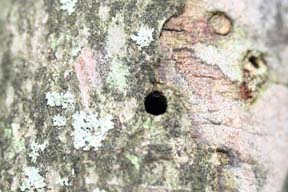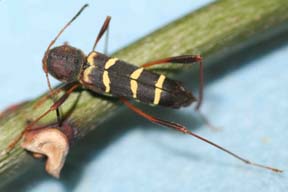Beetle Borer Damage in Ash | |
|---|---|
| June 14, 2007 | |
|
A number of other borers besides emerald ash borer (EAB) attack ash. Several cause internal damage similar to that of EAB but are readily separated by the trained eye. Others create emergence holes that are sometimes confused with those of EAB. Not only is it useful to determine that the damage is not caused by EAB, but it is also useful to know what caused the injury and what effect it may be having on the tree. The typical response from a client is, If it isnít EAB, what is it? Following are the most common beetle borers in ash in Illinois. Ash and privet borer is probably the borer most commonly confused with EAB. Like EAB, it tunnels in the cambium; but the tunnels are wider and deeper. Tunnels made by mature larvae are oval and about 3/16 inch across. Unlike EAB, ash and privet borer tunnels significantly into the sapwood. The white, legless larva is oval in cross-section. The tunnels are packed with frass, a combination of wood chips and fecal material produced by the larva. The larva pupates in the tunnel, and the resulting adult chews its way out through an oval, 3/16-inch-diameter hole. Although the hole is half again wider than that of the EAB and does not have the flat side of the D-shape, many convince themselves that it must be EAB. The adult is a longhorned borer, dark in color, with four tan spots on the elytra. It has long antennae. Most longhorned borers, also known as roundheaded borers, eat round emergence holes through the bark; but this insect makes oval holes. Ash and privet borer attacks dead and dying trees and parts of trees. It is commonly associated with storm damage, poor pruning wounds, and partial trunk dieback due to girdling roots. It does not attack healthy areas of the tree. Flatheaded appletree borer causes damage to ash, maple, serviceberry, hawthorn, crabapple, and other trees similar in appearance to that of ash and privet borer. It creates tunnels up to 3/16 inch in diameter in the cambium. These tunnels are oval in cross-section. The white, legless larvae grow to about 1-1/4 inches long. They have broad, flat heads that create the oval tunnels. The larva pupates in the tunnel, and the resulting adult chews it way out of the bark, creating a 3/16-inch-diameter, oval hole in the process. The adult is about 3/4 inch long, dark-colored, with small, indistinct light spots on its roughly textured back. Flatheaded appletree borer is a serious pest of young maple trees, commonly creating helical tunnels under the bark (just above the soil line) that extend completely around the tree, girdling it. Young maple transplants commonly die from this pestís attack. On rose family hosts, including serviceberry, hawthorn, and crabapple, it attacks and hastens the demise of older trees but is typically not a threat to healthy trees. It is similar in its attack of ash, being found in trees dying from other causes, as well as dead and dying tissue associated with storm damage and girdling roots. Redheaded ash borer is very common in dead and dying trees and portions of trees. It attacks not only ash but many other trees as well. The white, legless larva grows to about 1 inch long, eating oval, frass-filled tunnels through the sapwood. Pupation occurs in the tunnels, with the adult eating a round, 1/8-inch-diameter emergence hole through the bark, characteristic of the roundheaded borer that it is.  The adult is a longhorned beetle, having long antennae approaching half the body length. It is a slender beetle, ranging from 1/2 to 3/4 inch long. As with many longhorned beetles, the males are shorter and have longer antennae than the females. The pronotum, the broad area behind the head, is reddish, which is probably responsible for its common name. The wing covers are reddish brown, as are the legs and antennae. Four obvious yellow bands across the wing covers range from almost straight across to an inverted V-shape.  Adult redheaded ash borers are very active on the outside of affected trees. They run rapidly up and down the trunk. This activity, along with its long, slender legs, general coloration, and obvious antennae, commonly causes homeowners to report that these beetles look like wasps to them. Redheaded ash borers commonly attack dead and dying trees and parts of trees, not being a problem attacking healthy areas of trees. As such, it is not considered to be a pest, although it is an indication of dieback of at least part of the tree that may need attention. False powderpost beetle attacks dead and dying ash and other trees. The C-shaped, white, legless larvae tunnel throughout the wood, turning it into fine powderlike frass and sawdust. Fully grown larvae are about 1/4 inch long. The larvae pupate inside the branch or trunk, emerging as adult beetles through 1/8-inch-diameter round holes in the bark. Adult beetles are about 1/4 inch long and blackish, with down-turned heads. Dead branches and trunks are attacked repeatedly. Because this insect attacks only dead and dying branches and trunks, false powderpost beetle is not a threat to living trees or parts of trees. Eastern ash bark beetle attacks dead and dying trees and parts of trees; therefore, they are no threat to healthy trees. The female chews through the bark and makes a straight tunnel in the cambium. Along this tunnel, she lays a series of eggs. After completing a 1- to 2-inch tunnel, she commonly dies in the end of the tunnel. The eggs hatch into C-shaped, white, legless larvae that tunnel at right angles to the femaleís original tunnel. After tunneling and feeding for about 1-1/2 inches, the larvae pupate at the end of their tunnels. The adults that emerge from the pupae chew pinhead-sized round holes through the bark. Because the larvae tend to tunnel about the same distance from the straight tunnel that the female makes, the subsequent emergence holes tend to be in straight lines. | |
| Author: | Phil Nixon |
